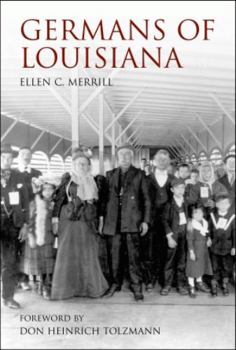Germans of Louisiana
Germans formed the largest foreign-speaking ethnic group of nineteenth-century Louisiana, larger than all the others combined. During the antebellum period, an estimated 12 percent of the New Orleans population was German, making the city the largest German colony below the Mason-Dixon line. Some later settlements moved upriver between New Orleans and Donaldsonville, near Lecompte, and in north Louisiana near Minden. Today, descendents of these...
Format:Hardcover
Language:English
ISBN:1589802446
ISBN13:9781589802445
Release Date:November 2004
Publisher:Pelican Publishing Company
Length:384 Pages
Weight:1.60 lbs.
Dimensions:1.3" x 6.3" x 9.2"
Related Subjects
HistoryCustomer Reviews
1 rating
An excellent starting place in the subject -- and about time, too
Published by Thriftbooks.com User , 15 years ago
Those not familiar with Louisiana's history often assume the non-English-speaking population of the colony and state is entirely French. Plus perhaps the Spanish, if they think about it. Long-time New Orleans residents would add the Italians and the Irish. The fact is, though, that the largest such group in Louisiana throughout the 19th century was German. New Orleans had the largest number of German-speakers in the South, with other large colonies near Rayne and in the area around Minden. Merrill is director of the German archive at the Historic New Orleans Collection and has a long academic career focusing on Louisiana's German past, so it's not surprising that she was the author of this first thorough study of the subject. The first German settlers, in fact, arrived here in 1724 as part of one of the several settlement schemes of John Law (whose nearly unbelievable life is the subject a number of other books). Among the first of them was Karl Friedrich Darensbourg, a German Swede of Baltic ancestry, who served as Commander of the German Coast in St. Charles Parish for forty-eight years -- and who has many present-day descendants still living in south Louisiana. After Louisiana became a state, its immigration following a more conventional pattern, with refugees from Napoleon's depredations in the Rhineland, Alsace, and Wurttemberg fleeing to the New World. Since the slave trade had become illegal in 1808, many of these came to the Southern states where there was a growing demand for cheap labor. Many other German arrivals at the Port of New Orleans embarked on river boats for points north, or headed for the German settlements in the Texas Hill Country. Later in the 19th century, the primary source for German immigrants had shifted to Prussia and Poland, which were the most densely populated part of the German Empire; these later arrivals didn't always have much in common with earlier settlers whose roots had been in southern Germany. Because of my own longstanding interest in migration patterns, I found this first third of the book to be the most interesting and useful section. Subsequent chapters are more sociological in character, addressing the subjects of German architecture in Louisiana, work and labor, religion and education, and art and music, plus the unique German contribution to popular recreation and entertainment: the biergarten. A final chapter provides an alphabetical survey of prominent German immigrants and Louisiana German-Americans, from Stanley Ochsner to Mel Ott. There is also a very thorough bibliography as an aid to further reading and research. Merrill's style is clear and matter-of-fact, and it's obvious that she knows far more than she could possibly cram into a single volume. But it's an excellent place to start.






